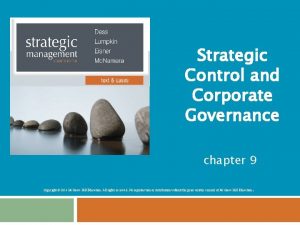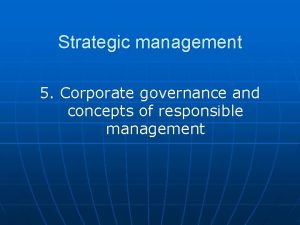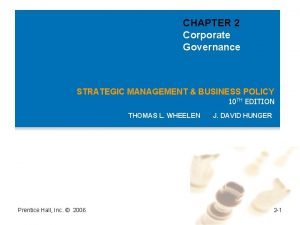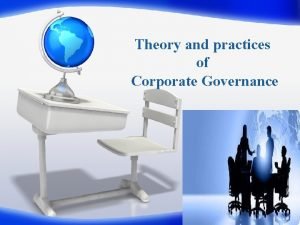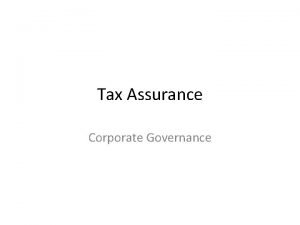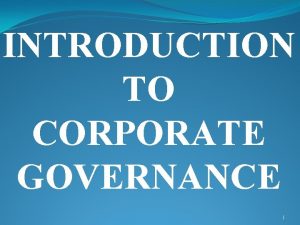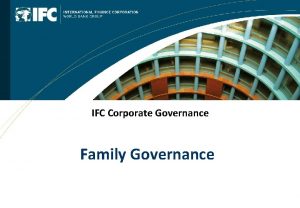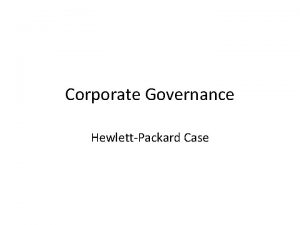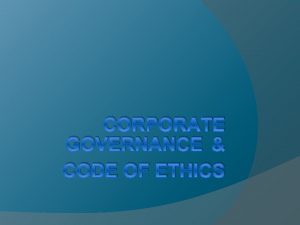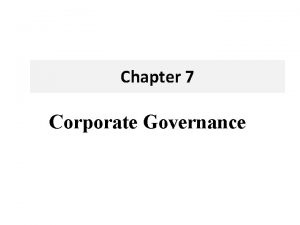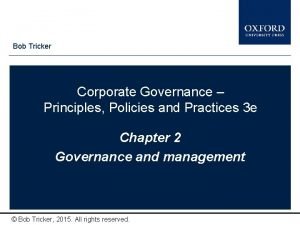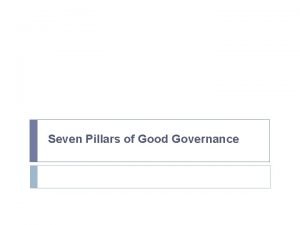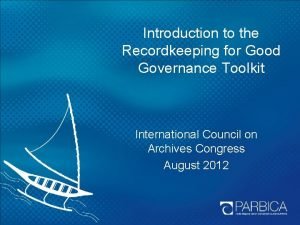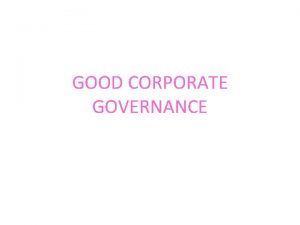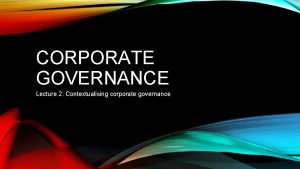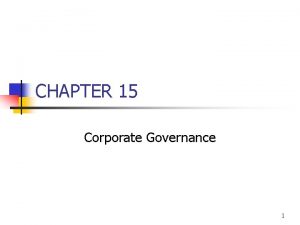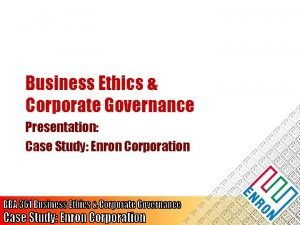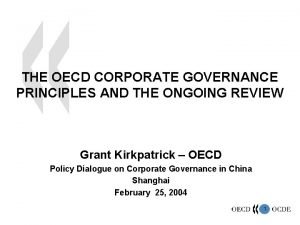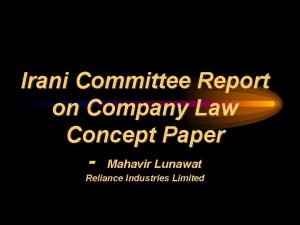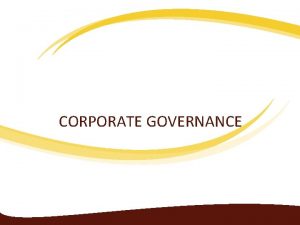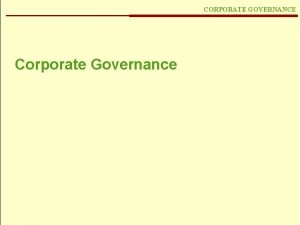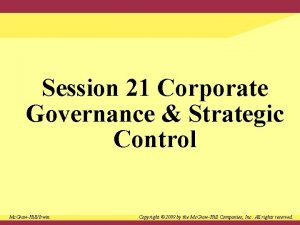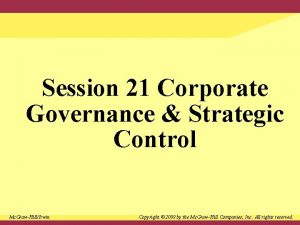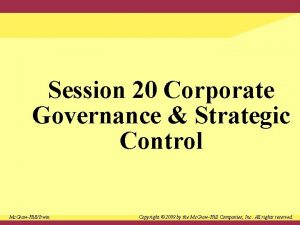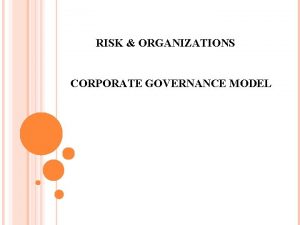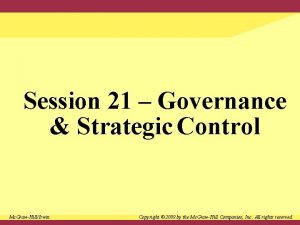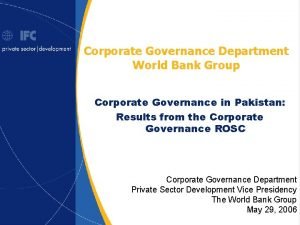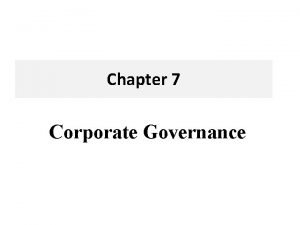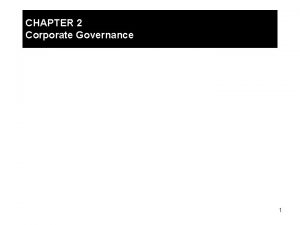Session 23 Corporate Governance Strategic Control Mc GrawHillIrwin






























- Slides: 30

Session 23 Corporate Governance & Strategic Control Mc. Graw-Hill/Irwin Copyright © 2009 by the Mc. Graw-Hill Companies, Inc. All rights reserved.

Learning Objective Describe Attributes of “Good” and “Bad” BODs Describe the requirements for Section 5 for the Implementation Analysis and Report 13 -2

Corporate Governance Issues discussed in the case or discovered in your research? If so, recommend corrective action. If no, move on to an evaluation of the BOD.

Board of Director Facts & Statistics The average board size of Fortune 500 companies is 12, of whom 9 are outside board members 16. 9% of board seats in the Fortune 100 are held by women Current average tenure of a CEO is between three to five years

Criteria used in BW’s The Best & Worst Boards shareholder accountability corporate social responsibility board quality board independence corporate performance independence stock ownership environment director quality board activism

Attributes of a Good Board INDEPENDENCE Friends and cronies of the CEO are out. Crucial panels like audit should contain no insiders. Cross-directorships are taboo

Attributes of a Good Board QUALITY Board meetings should include real, open debate. Directors need to be familiar with managers and conditions in the field

Attributes of a Good Board ACCOUNTABILITY Directors ought to hold serious stakes in the company. They should also be prepared to challenge under-performing CEOs

ENHANCING BOARD EFFECTIVENESS No More than Two Insiders No Insiders on Audit, Nominating, and Compensation Committees No Outsiders Drawing Fees from Company

ENHANCING BOARD EFFECTIVENESS No Interlocking Directorships Outsiders Meet Regularly without CEO All Directors Own Minimum of $100 k of Stock Board Stands for Election Every Year

ENHANCING BOARD EFFECTIVENESS Board’s Evaluate their own Performance Yearly Employed Directors sit on No More than 3 Boards Non-Employed than 6 Boards Directors sit on No More

ENHANCING BOARD EFFECTIVENESS At Least One Outsider with Experience in Core Business All Directors Attend at Least 75% of Meetings Board Size No Larger than 15

Best Boards of Directors 1. 3 M - With just one insider on its nine-member board the company gets high marks for independence. Outside directors include the CEOs of Lockheed-Martin, Allstate, and Amgen. Audit-committee chairman is the former CFO at Sears. No directors have business ties to the company. 2. APRIA HEALTHCARE - The board includes three top shareholder activists and features a separate chairman and CEO, a rarity. It moved quickly to accept the resignation of a former CEO when directors discovered that his wife had been hired for a company job.

Best Boards of Directors 3. COLGATE-PALMOLIVE - Directors are well-invested in the company and sit on few additional boards. The compensation committee has awarded premium-priced options to CEO Reuben Mark, which pay off only if stock appreciates by 10% to 70%. A new section on governance has been added to the latest proxy. 4. GENERAL ELECTRIC - This talent-packed board, with an unrivaled record of creating shareholder value, remains a favorite with governance experts. it recently added Ralph Larsen, former CEO of Johnson & Johnson and a longtime champion of good governance.

Best Boards of Directors 5. HOME DEPOT - With the departure of co-founder Bernard Marcus, the 12 -member board now has only two insiders. Independent directors meet regularly without management. Directors are required to visit 20 stores a year. 6. INTEL - One of the few boards that have a lead director. No insiders sit on the audit, compensation, or nominating committees. The board conducts an annual self-evaluation. Directors have big stakes in the company.

Best Boards of Directors 7. JOHNSON & JOHNSON - The high-powered board includes Delta Air Lines CEO Leo Mullin, Lucent Technologies Chairman Henry Schacht, and CSX CEO John Snow. The outside board members own plenty of J&J stock. Only one director sits on more than four boards. 8. MEDTRONIC - Governance gurus applaud the board's practice of holding regular meetings without the CEO and its performance evaluations for directors. Members are graded on willingness to "hold management accountable" and "meaningful participation" at meetings.

Best Boards of Directors 9. PFIZER - The board was second only to GE in overall approval by governance experts. Independent directors meet without the CEO. No Pfizer executives sit on the audit, nominating, or compensation committees. Stock transactions for directors and executives are posted on the company Web site. 10. TEXAS INSTRUMENTS - Making its third appearance on Business Week's Best Boards list, this highly independent board boasts a roster of well-invested outside directors, including the chief executives of Norfolk Southern, Kimberly-Clark, and Eastman Kodak.

Worst Boards of Directors 1. APPLE - Founder Steve Jobs owns just two shares in the company. Recently departed director Larry Ellison had none and had missed more than 25% of meetings in the past five years. The CEO of Micro Warehouse, which accounted for nearly 2. 9% of Apple's net sales in 2001, sits on the compensation committee. Since 2000, the board has awarded Jobs 27. 5 million stock options and a $90 million jet. 2. CONSECO - In 2000, the company spent a hefty $45 million to recruit CEO Gary Wendt from GE Capital. Despite the company's recent slide, in July--with the stock hovering at $1 --the board awarded Wendt an $8 million bonus. In August, the shares were delisted from the Big Board and now trade at 7 cents. None is a CEO. The board doesn't meet without the CEO present.

Worst Boards of Directors 3. DILLARDS - Before his death in February, Chairman William Dillard presided over a board that included seven directors with ties to the company, including four of his children. No nominating committee--allowing the CEO to hand-pick directors. With twothirds of board elected by holders of privately held Class B shares, Dillard's is exempt from NYSE governance rules. 4. GAP - Self-dealing includes contracts with the chairman's brother to build and remodel stores and a consulting deal with the__chairman's wife. Slow to replace outgoing CEO Mickey Drexler as performance declined. Interlocking directorship with Drexler sitting on the Apple board, while Apple's Steve Jobs sits on Gap's.

Worst Boards of Directors 4. KMART - The board's woes include multiple investigations of company accounting, a $501 million profit restatement, and a federal grand jury probe into pay practices. The board was passive as the company's performance deteriorated before a bankruptcy filing in January. Meanwhile, the board approved $28 million in retention loans to 25 top executives. 6. QWEST - Founder Philip Anschutz has extensive dealings with the company and sits on compensation and nominating committees. The SEC is probing whether Qwest used "swap" transactions to boost revenue. The compensation committee--described as "comatose" by one expert--awarded ex-CEO Joseph Nacchio an $88 million pay package in 2001, one of the worst years in the company's history. No outside director has operating experience in company's core business.

Worst Boards of Directors 7. TYSON FOODS - Out of 15 board members, 10 have ties to the company, including seven who have extensive business dealings. CEO John Tyson got a $2. 1 million bonus for negotiating the acquisition of meatpacker IBP--which Tyson Foods tried unsuccessfully to back out of--in a year when net income fell 42%. Feds say the company for years conspired to smuggle workers from Mexico for its U. S. poultry-processing plants, a charge Tyson denies. 8. XEROX - The bungled succession of Paul Allaire, accusations of funny accounting, billions in shareholder wealth up in smoke, and a decades-long failure to keep up with changing technology add up to an ineffectual board. With departures of Allaire and CFO Barry Romeril, the board is far more independent. But too many directors sit on too many boards. Director Vernon Jordan's law firm provides legal services.

Establishing Strategic Controls

Establishing Strategic Controls Strategic control is concerned with tracking a strategy as it is being implemented, detecting problems or changes in its underlying premises, and making necessary adjustments Characterized as a form of “steering control” 13 -23

Types of Strategic Control For Section 6 of the Implementation Report be sure to cover each of these areas Premise control Strategic surveillance Special alert control Implementation control 13 -24

Premise Control Premise control is designed to check systematically and continuously whether the premises on which the strategy is based are still valid Environmental factors Industry factors 13 -25

Strategic Surveillance Strategic surveillance is designed to monitor a broad range of events inside and outside the firm that are likely to affect the course of its strategy Strategic surveillance must be kept as unfocused as possible Despite its looseness, strategic surveillance provides an ongoing, broad-based vigilance in all daily operations 13 -26

Special Alert Control A special alert control is the thorough, and often rapid, reconsideration of the firm’s strategy because of a sudden, unexpected event A drastic event should trigger an immediate and intense reassessment of the firm’s strategy and its current strategic situation Crisis teams Contingency plans 13 -27

Implementation Control Strategy implementation takes place as series of steps, programs, investments, and moves that occur over an extended time Implementation control is designed to assess whether the overall strategy should be changed in light of the results associated with the incremental actions that implement the overall strategy Monitoring strategic thrusts Milestone reviews 13 -28

Balanced Scorecard Methodology An alternative approach linking operational and strategic control, developed by Harvard Business School professors Robert Kaplan and David Norton, is a system they names the balanced scorecard The balanced scorecard is a management system (not only a measurement system) that enables companies to clarify their strategies, translate them into action, and provide meaningful feedback 13 -29

Balanced Scorecard Four perspectives: 1. The learning and growth perspective: How well are we continuously improving and creating value? 2. The business process perspective: What are our core competencies and areas of operational excellence? 3. The customer perspective: How satisfied are our customers? 4. The financial perspective: How are we doing for our shareholders? 13 -30
 Informational and behavioral control
Informational and behavioral control Objective of corporate finance
Objective of corporate finance What is ownership
What is ownership Corporate governance in strategic management
Corporate governance in strategic management Corporate governance strategic management
Corporate governance strategic management Sociological theory in corporate governance
Sociological theory in corporate governance Corporate governance definitie
Corporate governance definitie Isu dan riset kontemporer corporate governance
Isu dan riset kontemporer corporate governance Anglo american model of corporate governance
Anglo american model of corporate governance Family governance definition
Family governance definition Corporate governance in sri lanka
Corporate governance in sri lanka Corporate governance code of maldives
Corporate governance code of maldives Hp corporate governance
Hp corporate governance P&g code of conduct
P&g code of conduct Meaning of corporate governance
Meaning of corporate governance Bob tricker corporate governance
Bob tricker corporate governance Approaches of corporate governance
Approaches of corporate governance Five pillars of good governance
Five pillars of good governance Corporate governance is a form of
Corporate governance is a form of Corporate governance tool kit
Corporate governance tool kit Corporate social responsibility and good governance
Corporate social responsibility and good governance Latar belakang munculnya gcg
Latar belakang munculnya gcg Corporate governance lecture
Corporate governance lecture Potential problems in corporate governance
Potential problems in corporate governance Chapter 10 corporate governance
Chapter 10 corporate governance Case study on business ethics and corporate governance
Case study on business ethics and corporate governance Cadbury report ppt
Cadbury report ppt Oecd corporate governance principles
Oecd corporate governance principles Corporate governance oecd
Corporate governance oecd Corporate governance definition
Corporate governance definition Irani committee report
Irani committee report
